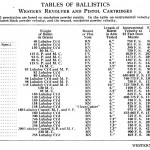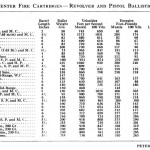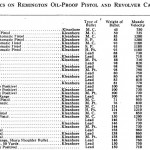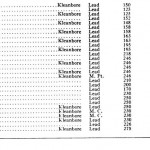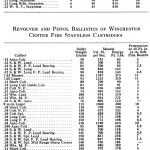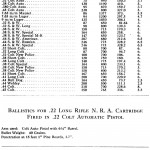The following information on rear and front sights for revolvers comes from Section 31 of Shooting by J. Henry FitzGerald. Shooting is also available to purchase in print.
Revolvers and automatic pistols are very well adapted for hunting; the only trouble seems to be that we have remained in the same old rut. As soon as we think of a hunting trip our thoughts go to the high-power rifle as a companion. When styles change in hunting arms as they have in ladies’ wearing apparel, I expect to see the two-inch barrel revolver the most popular of all hunting arms.
Many hunters in the West are now using the hand gun for hunting. My friend, Elmer Keith, can get his game at as long a range with his old Peace Maker as the average hunter can with his favorite rifle, and there are many others doing the same thing.
Some years ago I entered a match with a seven and one-half inch Officer’s Model revolver in which were eleven other contestants armed with their hunting rifles. Now it is a known fact that very few hunters can group their shots in an eighteen-inch circle at two hundred yards. I am not saying this is true of sporting Springfields and other target arms that are used for hunting trips. I mean the ordinary hunting arms and the ordinary hunter behind the gun. However, my revolver was properly sighted for two hundred yard shooting, fitted with a small micrometer rear sight brazed to regular rear sight, and I was fortunate in getting thirty-four out of a possible fifty on the old army target with an eight-inch black and won the match. I am not speaking of this as a wonderful score, but a fair average of what a man can do with the hand gun. This score would, of course, be impossible on a windy day.
The ease with which a revolver may be carried, compared with the seven-pound rifle in the morning which is seventeen pounds in the afternoon, would lead any one to think that the little hand guns have some advantages. It is not so much the model of the arm carried on a hunting trip as the ability of the hunter to place a bullet in a vital spot. A miss is just as effective with a revolver as it is with the most powerful rifle.
For long shots with the revolver the prone position may be used, holding the revolver with both hands, or resting the revolver against a tree, or sitting back against a tree or stone supporting the revolver with both hands and knees. This is very accurate for long range shooting if time permits all this preparation, but I do not believe that any good revolver shot would accept such aid up to one hundred yards; the average distance in wooded country where game is shot is between twenty-five and fifty yards. The same tricks are used with a revolver as with a rifle in hunting or stalking game.
We may now speak of the different cartridges and their values as game stoppers. In the section on cartridges as man stoppers, no lengthy explanation was given, but if my readers feel blood-thirsty they may apply the values given in this section to that subject. Perhaps every one will not agree with me on the relative value given here, as many reload a more powerful cartridge than produced by the ammunition companies. They may use a different shape and weight of bullet and a greater powder charge, but I have no means of knowing just what these special loads are and in this section only factory loads will be mentioned.
The cartridges recommended for hunting are the .45 Colt, .44 Winchester, .38 Winchester, .45 Automatic, .38 Automatic, .44 S&W Special, .38 S&W, and Colt Special, not forgetting that little partridge load, the .22 Long Rifle. The 9 mm. Luger, 7.63 Mauser, and 7.65 Luger, while little used in this country, and shooting a very light bullet, may be mentioned as possible game cartridges.
To my mind the .45 caliber Colt cartridge heads the list as the finest cartridge for hunting with the hand gun. The smokeless powder charge with two hundred and fifty grain bullet, seven hundred and seventy feet per second, and a striking force of three hundred and thirty pounds added to the shape of the bullet is sufficient for almost any purpose that a hunting arm would be used for. With the black powder load it is the most powerful hand gun bullet on the market, a velocity of nine hundred and ten feet per second and a striking force of four hundred and sixty pounds.
I use in my .45 caliber revolvers two black powder cartridges and four smokeless powder cartridges and find this combination satisfactory whether on a hunting trip or in peace times. Andrew J. Palmer of Bridgeport, Connecticut, gave me some black powder cartridges, .45 Colt, a short time ago that registered five hundred twenty-five pounds’ striking force and made my favorite two-inch forty-five revolvers very nervous.
The .44 Winchester is next on the list. While it has not quite as long a range as the .38 Winchester cartridge, it does have a larger and heavier bullet and I consider it a better game cartridge. Bullet weight for the .44 Winchester cartridge is 200 grains, velocity 919 feet per second at muzzle, and muzzle energy 375 foot-pounds, and the .38 Winchester with a bullet of 180 grains, muzzle velocity 950 feet per second, and muzzle energy of 360 foot-pounds. The last two named are very close in power and performance. The .45 Colt automatic 230-grain bullet has a muzzle velocity 809 feet per second, muzzle energy 335 foot-pounds. The 200-grain bullet has a muzzle velocity of 910 feet per second, muzzle energy 368 foot-pounds. The .38 automatic has a muzzle velocity of 1146 to 1200 feet per second and a muzzle energy of 379 to 410 foot-pounds. I hope now that a real pistol for this cartridge is on the market that the ammunition companies will increase the velocity to at least 1250 feet per second and come forward with a real hollow point bullet and other bullets adaptable for game shooting. We would then have a long range pistol cartridge with penetration accuracy, and stopping power to suit the most exacting.
I know I am going to hear some comments about putting the .44 Special cartridge away down here, but it is universally used with smokeless powder and a 246-grain bullet only has a muzzle velocity of 770 feet per second and a muzzle energy of 320 foot-pounds. If black powder were used it would have a muzzle velocity of 820 feet per second and a muzzle energy of 370 foot-pounds.
The .38 Colt and S&W Special bullet weighing 158 grains using black powder has a muzzle velocity of 960 feet per second and a muzzle energy of 320 foot-pounds. Using smokeless powder it has a muzzle velocity of 860 feet per second and a muzzle energy of 260 foot-pounds. The 9 mm. Luger bullet weighing 124 grains has a muzzle velocity of 1040 feet per second and a muzzle energy of 300 foot-pounds. The 7.63 Mauser 85-grain bullet has a muzzle velocity of 1397 feet per second and a muzzle energy of 373 foot-pounds. The 7.65 Luger bullet weighing 93 grains has a muzzle velocity of 1225 feet per second and a muzzle energy of 310 foot-pounds.
A cartridge which should be well up on the list is the .455 cartridge bullet weighing 265 grains, with a muzzle velocity of 758 feet per second and a muzzle energy of 337 foot-pounds. We must not forget the little .22 Long Rifle bullet weighing 40 grains, with a velocity of 910 feet per second and muzzle energy of 58 foot-pounds. This last mentioned cartridge is much used in both revolvers and automatic pistols by trappers and hunters for small game shooting. It may be procured with a hollow point.
Hunting is a matter of practice on moving objects and I feel that if any one, after a reasonable amount of preparation, should take his favorite side arm into the woods instead of a rifle he would be pleased with the result. I prefer two revolvers to any of my rifles when hunting (I never go after mountain goats). Two .45 caliber revolvers will make any bear wish he had lived a better life if the hunter does not get bear fever.
Camp Perry practice for running deer and running man shooting is presided over by Colonel Critchfield and it is excellent practice. I could see surprise written on many faces because of the misses with both rifle and revolver when the moving targets were first tried, but after a short period of practice the smiles came back and they were registering hits with the revolvers and rifles at fifty yards.
The following ballistic tables will show the comparative power of the different cartridges and the proper placing of bullets is the answer to the full or empty game bag. I have derived more pleasure in hunting with revolvers and automatic pistols then I ever experienced when carrying a rifle and on stormy days the arms were dry when I arrived in camp. (Click to enlarge)
